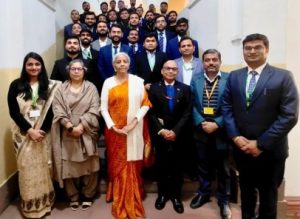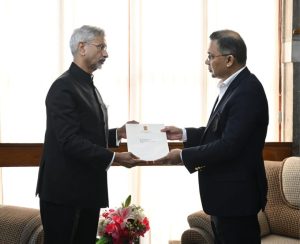Parched Delhi goes begging for water

Photo Credit Twitter Mr Sinha
By S Jha
New Delhi, June 12: At a stone’s throw from the Indian Parliament, residents in the quarters for the government employees are buying 20-litre water bottles. Delhi’s water crisis has reached unprecedented levels, which could be the worst in a decade.
The mainstream media conveniently overlooks the national capital’s worst crisis, pushing the perception that the people in the jhuggis only face water crisis.
The potable water supply in some of the prominent areas of Delhi has been reduced to 15-minute a day. Some of the areas on the outskirts have gone dry.
Delhi Chief Minister Arvind Kejriwal has called upon his Haryana counterpart Manohar Lal Khattar to release waters on the humanitarian grounds. The Bharatiya Janata Party (BJP) leaders have also made similar appeals.
The water tanker mafia is going for the kill, with the media reports suggesting that they have hiked the rates. Even they are said to be in short supply. However, it remains a mystery that the water tankers manage to source waters even while the Delhi Jal Board cries the water table going down in the national capital and its water treatment plants having much reduced water levels.
Delhi’s acute water crisis isn’t new. It was there a decade ago, it is now in the worst form, and if the trend stays and solutions remain elusive the people in the national capital could be staring at tough times ahead.
Delhi’s lifeline for ages had been the Yamuna River. It nourished life from Haryana, Delhi to the Braj parts of Uttar Pradesh.
But the rapid urbanization killed the river in Delhi. The colonies came up on the flood plains of Yamuna. Grand temples also rose on its floodplain, and a showcase Commonwealth Games village also was built on the riverbed.
The city that killed its river is now parched.
Former Delhi Chief Minister Shiela Dikshit knew that the revival of Yamuna is the only answer to solve the water crisis in the national capital even while she built the Sonia Vihar treatment plant which became the lifeline for the South and West Delhi.
Dikshit’s politics revolved around the resident welfare associations, and she sought to address the perennial water crisis by building underground water reservoirs in all parts of the city. Her efforts gave Delhi a breathing space on water front for a few years.
That breathing space now stands exhausted amid the deepening of the water crisis. Dikshit had essentially pushed the water crisis by a few years to buy time for tangible futuristic solutions.
The former Lieutenant Governor of Delhi Tajendra Khanna had prepared a blueprint for the revival of the Yamuna River after holding extensive deliberations with the officials of the National Capital Territory Government of Delhi while also taking on board the political and bureaucratic set ups of Haryana and Himachal Pradesh.
Yamuna is a snow-fed river. After Haryana, the river turns into nullah and the majestic Taj Mahal wears the decay of the river with its own paling exterior.
The blueprint had sought building a grad reservoir in Himachal Pradesh to ensure regular flow of waters in Yamuna while the river would have been physically deep-cleaned of garbage all through its course. The concrete works would have slowed evaporation of waters. The zero flow of sewage, chemical from the domestic and industrial waste would have helped Yamuna stay healthy.
But the report was made at a time when the Manmohan Singh-led UPA government had stared becoming lame-duck with the media leakages of scams after scams hitting the national headlines.
Dikshit’s successor Arvind Kejriwal had no time to read that report.







